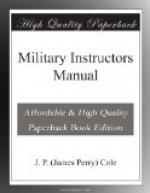Owing to the small explosion which occurs with these shells, they are liable to be mistaken for blinds, and even when the gas is smelt men may not realize its possibly dangerous character at once and so may delay putting on respirators or helmets until too late. Men sleeping in dug-outs may be seriously affected unless they are roused. Men in the open air are unlikely to be seriously affected by poison gas shells, provided they put on respirators or helmets on first experiencing the gas. The following points should therefore be attended to:
(i) All shells which explode with a small detonation or appear to be blind should be regarded with particular attention; the respirator or helmet should be put on at the first indication of gas and blanket protection of shelters adjusted.
(ii) Arrangements must be made for giving a Local alarm in the event of a sudden and intense bombardment with poison gas shells, but care must be taken that this alarm is not confused with the main alarm. Strombos horns must on no account be used to give warning of a gas shell bombardment.
(iii) All shelters in the vicinity of an area bombarded with poison gas shells must be visited and any sleeping men roused.
(iv.) Box respirators or helmets should continue to be worn throughout the area bombarded with poison gas shells until the order is given by the local unit Commander for their removal.
Lachrymatory or “tear” shells are frequently used by the enemy for the purpose of hindering the movements of troops, for preventing the bringing up of supports, or for interfering with the action of artillery. Owing to the deadly nature of poison gas shells, however, the precautions given in paragraph 60 above, must be taken for all gas shells. The goggles are intended for use after lachrymatory bombardments only, in cases where the irritant gas persists in the neighborhood.
K. Action Subsequent to a Gas Attack:
1. GENERAL:
The most important measure to be taken after a cloud gas attack is to prepare for a further attack. The enemy frequently sends several successive waves of gas at intervals varying from a few minutes up to several hours and it is therefore necessary to be on the alert to combat this procedure. The following measures should be adopted as soon as the gas cloud has passed:
(a) Removal of
respirators.—Anti-gas fans should be used
to
assist
in clearing the trenches of gas, so as to admit of
respirators
being removed. Respirators and helmets must not
be
removed until permission has been given by the Company
Commander.
A sharp look out must be kept for a repetition of the gas attack, as long as the wind continues in a dangerous quarter.
2. MOVEMENT:




